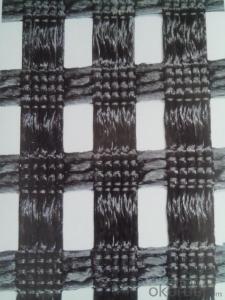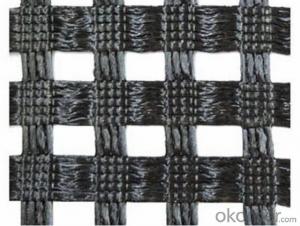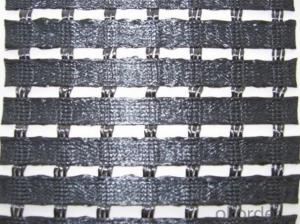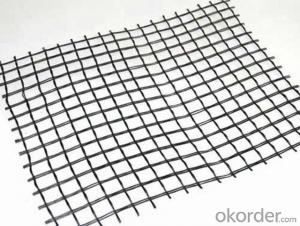Polyester Biaxial/Uniaxial Geogrid for Construction
- Loading Port:
- China main port
- Payment Terms:
- TT or LC
- Min Order Qty:
- 20000 m²
- Supply Capability:
- 2000000 m²/month
OKorder Service Pledge
OKorder Financial Service
You Might Also Like
1. Polyester Geogrid Description
Polyester geogrid is made by polyester, through special processing, and polyethylene (PE) or polypropylene (PP), and adding other assistants, by extrusion into composite type high tensile belt, and the surface is rough textured, for high strength reinforced geotextile strips.
The single band, the longitudinal, transverse certain space preparation or clamping arrangement, with special reinforcement welding technology welding the connection point bonding and molding, is reinforced with Geogrid.
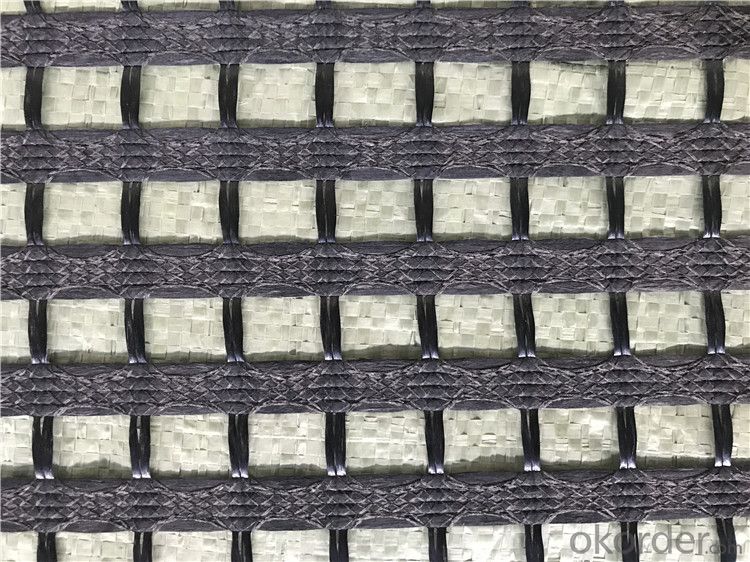
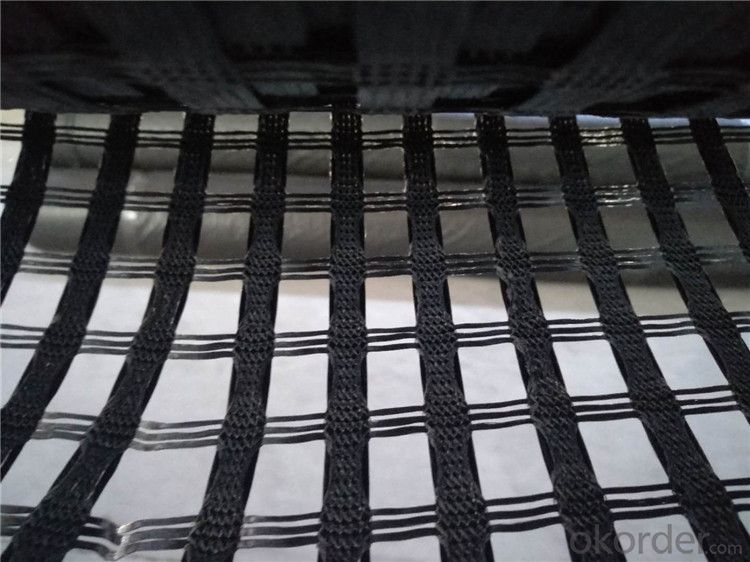
2. Geogrid Applications
1)Make reinforce treatment for various kinds of soft soil foundation to evenly distribute load stress and reduce uneven settlement, not easy to generate static electricity, and flammability property good in the coal mine. It is easy to wash coal.
2) Used in highway, railway, port, airport and municipal project. Support in the recovery working face of coal mine and roadway in the coal mine.
3. Geogrid Properties
1) High tensile strength
2) Low elongation
3) Anti-erosion, anti-aging
4) Good affinity with base
5)Light weight, water drainage
4. Geogrid Specification
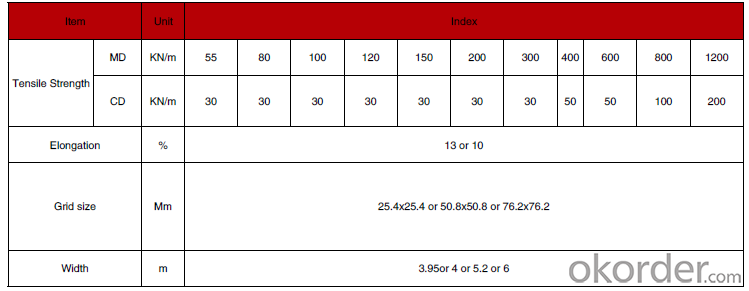
FAQ:
Q:How about the delivery time?
A:Lead time since receipt of 30% T/T deposit payment: 3 weeks.
Q:What kind of payments does jenor support?
A:T/T, L/C, Cash are accepted.
Q:What's are the MOQ?
A:We can according to your condition to set the MOQ.
And we can provide you samples for quality inspection.
Q:Do you charge for the samples?
A:Accordeing to our company policy, the samples are freee, we only charge the freight fee. And we will return the freight fee If you set the order .
Q:Can you produce the product according to customers' requirements ?
A:Sure, we are professional manufacturer, OEM and ODM are both welcome.
- Q:What is the recommended geogrid aperture size?
- The recommended geogrid aperture size depends on various factors such as the type of soil and the intended application. It is best to consult with a geotechnical engineer or refer to specific industry standards and guidelines to determine the appropriate geogrid aperture size for a given project.
- Q:As well as how to fill out the form, thank you!! Urgently
- Do you need a test report for the two-way geogrid or something?
- Q:The cheapest two-way plastic geogrid manufacturers, two-way plastic geogrid prices?
- As the polymer in the manufacture of plastic polymer in the process of heating with the extension of the process of re orientation, strengthen the link between the molecular chain force, to achieve the purpose of improving its strength. Its elongation rate is only 10% ~ ~ of the original plate of 15%
- Q:Can geogrids be used in geothermal energy systems?
- Yes, geogrids can be used in geothermal energy systems. Geogrids are often used to reinforce soil structures and provide stability, which can be beneficial in supporting the infrastructure and components of geothermal energy systems. They can help prevent soil erosion, provide load-bearing capacity, and enhance the overall performance and longevity of the system.
- Q:How do geogrids enhance the stability of steep railway embankments?
- Geogrids enhance the stability of steep railway embankments by providing reinforcement and preventing soil erosion. They are placed within the soil layers, creating a strong interlocking system that distributes the applied loads and increases the overall strength of the embankment. This helps to prevent slope failures, maintain the embankment's shape, and improve its resistance to lateral movements and settlement. Geogrids also promote better drainage and reduce the risk of water accumulation, which further enhances the stability of the embankment.
- Q:What are the typical dimensions and sizes of geogrids?
- Geogrids typically come in varying dimensions and sizes, depending on the specific application and engineering requirements. However, common dimensions for geogrids range from 1 to 6 meters in width and 50 to 100 meters in length. The size of the apertures or openings in the geogrid can also vary, typically ranging from 20 to 50 millimeters. It is important to consider the specific project needs and consult with an engineer to determine the most suitable dimensions and sizes for geogrids.
- Q:The price of the type of geogrid manufacturers is the best phone
- Thermal stability - the melting temperature of the glass fiber is above 1000 DEG C, which ensures the stability of the fiberglass geogrid in the paving operation.
- Q:How do geogrids improve the stability of slopes?
- Geogrids improve the stability of slopes by providing reinforcement to the soil or rock materials. They are installed within the slope to distribute the applied load over a larger area, reducing stress concentrations. This reinforcement helps to prevent soil or rock movement, enhancing slope stability and reducing the risk of slope failure.
- Q:Are geogrids resistant to temperature variations?
- Yes, geogrids are generally resistant to temperature variations. They are designed to withstand a wide range of temperatures, from extreme cold to intense heat, without significant degradation or loss of performance. This makes them suitable for various applications in different climate conditions.
- Q:How do geogrids enhance the performance of geocomposite drainage systems?
- Geogrids enhance the performance of geocomposite drainage systems by providing structural reinforcement and preventing the formation of localized stress points. They distribute the load more evenly, increase the overall stability and strength of the system, and minimize the risk of soil settlement. Additionally, geogrids help to improve water flow and drainage efficiency, reducing the likelihood of clogging and ensuring the long-term effectiveness of the geocomposite drainage system.
1. Manufacturer Overview |
|
|---|---|
| Location | |
| Year Established | |
| Annual Output Value | |
| Main Markets | |
| Company Certifications | |
2. Manufacturer Certificates |
|
|---|---|
| a) Certification Name | |
| Range | |
| Reference | |
| Validity Period | |
3. Manufacturer Capability |
|
|---|---|
| a)Trade Capacity | |
| Nearest Port | |
| Export Percentage | |
| No.of Employees in Trade Department | |
| Language Spoken: | |
| b)Factory Information | |
| Factory Size: | |
| No. of Production Lines | |
| Contract Manufacturing | |
| Product Price Range | |
Send your message to us
Polyester Biaxial/Uniaxial Geogrid for Construction
- Loading Port:
- China main port
- Payment Terms:
- TT or LC
- Min Order Qty:
- 20000 m²
- Supply Capability:
- 2000000 m²/month
OKorder Service Pledge
OKorder Financial Service
Similar products
New products
Hot products
Hot Searches
Related keywords
